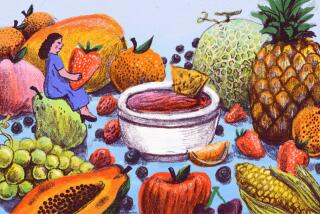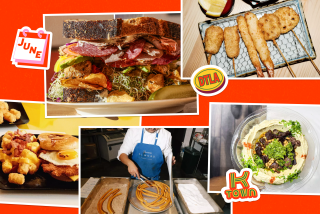The Sweetest Season Is Back
After the drama of the El Nino and La Nina years of the late ‘90s, with alternately scorching and drenching springs and early summers sending California farmers and fruit lovers on a wild roller-coaster ride of euphoria and heartache, normalcy seems kind of dull. Not that that’s a bad thing.
This summer’s fruit harvest will be about the same as last year’s. That means good supplies and good quality. And how can you argue with that?
California’s peach, nectarine, strawberry, grape, melon, apricot and cherry harvests are all expected to be at or near record levels. That normally means low prices and good quality (weather that encourages lots of fruit also usually leads to good fruit).
The only black spot right now is plums, which are notoriously troublesome due to their smooth, easily marred skin and the fact that their growing areas attract hailstorms the way trailer parks lure tornadoes. This year’s plum harvest will be about 25% short of last year’s because of early spring hail.
You also might find slim pickings for cherries later this summer. The Wenatchee valley, Washington state’s prime growing area, was hit by devastating rainstorms in late June that have reduced the state’s total crop an estimated 40%. Though California’s harvest was a record (and, after getting off to a slow start, has extremely high quality), most late summer cherries come from the Northwest, while spring and early summer fruit comes from California.
Peaches, Nectarines and Plums
How To Pick ‘Em: The trick to buying peaches and nectarines is not to be fooled by the red color on the skin. That doesn’t tell you whether the fruit is ripe; it’s a varietal characteristic. Look for the background color, which should be pale yellow to golden. If there is a tinge of green, that’s probably OK too. To tell when the fruit is really ready to eat, there is nothing like your sense of smell. Really good peaches, plums and nectarines possess a strong fruity fragrance that you can smell across the kitchen. Don’t be put off by plums that look dusty--that’s called “bloom,” and it’s a natural yeast dust that actually helps prevent spoilage. Bloom is also a good indication that the plums have not been overly handled.
How to Store ‘Em: If the fruit you buy at the grocery isn’t as ripe as it could be, you can improve it by putting it in a paper bag and leaving it at room temperature. Check it every day; the aroma and the slightly soft flesh will tell you when it’s ready. Once peaches, plums and nectarines are ripe, they’ll last a day or two at room temperature. Longer than that and they ought to be refrigerated, though that will diminish their flavor somewhat. Do not wash the fruit before chilling it; the extra moisture will encourage spoilage. Rather, give it a rinse in cold water before serving it.
One Good Dish: One of the simplest desserts you can make with peaches, plums and nectarines is a crisp. Toss the fruit with a little bit of sugar and a tablespoon or so of flour and layer it in a shallow baking dish. In a food processor, pulse 1/4 cup butter with 1/4 cup sugar, 1/2 cup flour and a dash of salt until it forms rough crumbs. Sprinkle the pastry mixture over the fruit and bake at 400 degrees until the top is brown and the fruit has turned to jam, about 40 minutes.
Berries
How to Pick ‘Em: Choose bush berries--raspberries, blackberries and olallieberries--by firmness. There should be no squished berries in the basket and certainly no moldy ones. With the strawberry varieties that dominate these days, the best fruit will probably be the darkest in color.
How to Store ‘Em: Water is the enemy of all berries, but especially of the bush berries. Their skins are so thin and delicate that water not only encourages spoilage, it will actually suck out juice. In fact, many growers insist that you shouldn’t wash berries at all before using them. That may be a little extreme, but you should certainly limit their bath time to only the briefest of showers.
One Good Dish: All berries should be treated as simply as possible. The very best way to serve them is with some sort of cream: either liquid, whipped or frozen. Add a little pastry for some texture--even crumbled cookies, such as ginger snaps, are fine--and you’ve got heaven.
Melons
How to Pick ‘Em: There is no one rule for all melons. With cantaloupes, look for a good, raised netting on the shell and make sure there is no stem left--ripe cantaloupes “slip” from their vines. Honeydews are completely smooth and they are cut from the vines, so they always have a little knob. Look for a uniformly golden creamy color to the rind. If you see a honeydew with brown speckles, buy it--that’s sugar that’s bled through the rind. It’s usually washed off at supermarkets, but occasionally you’ll get lucky. With both types--and with the various specialty melons you find in the market these days--the best clue to ripeness is a powerful floral aroma at the stem end. Once again, the nose knows.
How to Store ‘Em: Store melons at room temperature until they are fully ripe and fragrant. Then you can put them into the refrigerator to extend their life.
One Good Dish: The simplest preparation is the best when it comes to good melons. Wrap a slice of melon in a slice of good prosciutto for an appetizer. And if your melons are something less than perfect, or if you just can’t resist gilding lilies, you can serve sliced melon in a cold sugar syrup (about half as much sugar as water, cooked until clear and then chilled; a sprig of mint and some lime zest added during the cooling give a nice complexity).
Watermelons
How to Pick ‘Em: Look for a deep green color overall, with a golden spot on one side (that shows the watermelon lay in the patch long enough to get sugar). And, of course, there should be a solid, satisfying, hollow thump. Surprisingly, some melon pros recommend buying cut watermelons to be really sure. Though other indicators can be iffy, a really sweet watermelon will always have a deep red color.
How to Store ‘Em: Watermelons do not improve after picking, so they should be refrigerated as soon as you get them home.
One Good Dish: Watermelons make a wonderfully cooling summer drink. Simply puree some with a tablespoon or so of sugar (if necessary) and serve it over ice. Raspberries add a bright spot of tartness.
Grapes
How to Pick ‘Em: Grapes are almost always sweet and tart. And almost all varieties taste pretty much the same. Buying green, red or what the trade calls “black” is really a decorating decision. The dominant grape in California is the Thompson Seedless, a green grape, and it actually can be quite good. If you ever find Thompsons that are almost amber in color--as opposed to pale green--you won’t believe the difference in taste. That simple sugar turns to honey. Of course, you’ll almost never see them. When grapes get that ripe, they have a discouraging tendency to fall off their stems; that’s called “shatter,” and supermarkets hate it.
How to Store ‘Em: Grapes should be refrigerated as soon as you get them home. Do not wash them until just before eating: Excess moisture leads quickly to spoilage.
One Good Dish: Cook a grape?
Spiced Peaches
Active Work Time: 2 hours * Total Preparation Time: 3 hours
From “Recipes From Home” by David Page and Barbara Shinn (Artisan, $30). Use early, firm peaches for this recipe.
9 pounds firm peaches
6 cups granulated sugar
Water
1 teaspoon minced candied ginger
2 (3-inch) cinnamon sticks, broken into 4 pieces each
8 allspice berries
Peel the peaches: Score each peach with a shallow X on the underside. Bring a large pot of water to a gentle boil. Fill a large bowl with ice water. Dip the peaches 4 at a time into the boiling water and scald them for about 30 seconds, then plunge them into the ice water to cool. Slip the skins off, halve the peaches and gently remove the pits. If the skins are tough to remove, use a very sharp paring knife to cut them off. If the peaches do not release easily from the stone, try quartering them to get a better handle on them to remove the stone.
Combine the sugar, 6 cups of water, ginger, cinnamon sticks and allspice berries in a large pot over medium heat. Simmer until the sugar dissolves, about 15 minutes.
Pack the peaches as tightly as possible into 8 hot sterilized pint mason jars. Ladle the hot syrup over them and evenly distribute the spices among the jars. Leave 1/4-inch headroom from the top of the jar. Wipe the rims and seal the jars. Process in a boiling water bath for 20 minutes.
8 pint jars. Each of 32 servings: 72 calories; 0 sodium; 0 cholesterol; 0 fat; 0 saturated fat; 19 grams carbohydrates; 1 gram protein; 0.75 gram fiber.
Fruit Cobbler
Active Work Time: 20 minutes * Total Preparation Time: 1 1/2 hours
From “Mrs. Wilkes’ Boardinghouse Cookbook” (Ten Speed Press, $29.95).
2 cups cored and sliced apples, pitted cherries or berries, or 2 (16-ounce) cans fruit in juice, drained
3 tablespoons butter or margarine
1 tablespoon grated lemon zest
1 1/2 cups sugar, divided
3 tablespoons cornstarch
1 cup flour
1 teaspoon baking powder
1/2 teaspoon salt
1 cup milk
1/4 cup shortening
1 teaspoon vanilla extract
1 egg
Heat the oven to 350 degrees.
Combine the fruit, butter and lemon zest in a saucepan. In a small bowl, combine 3/4 cup of the sugar and the cornstarch and stir well. Add the cornstarch mixture to the fruit mixture. Cook over medium heat, stirring constantly, until the sugar has dissolved and the mixture has thickened slightly, about 5 minutes.
Pour the fruit mixture into a 9x7-inch baking dish and let it stand while making the topping.
Sift the flour, the remaining 3/4 cup of sugar, baking powder and salt into a mixing bowl. Add the milk, shortening, vanilla and egg. Beat at medium speed for 2 or 3 minutes. Spoon the batter over the fruit mixture.
Bake the cobber until it’s golden brown and the edges are bubbly, 45 to 50 minutes.
8 servings. Each serving: 357 calories; 272 mg sodium; 42 mg cholesterol; 13 grams fat; 5 grams saturated fat; 59 grams carbohydrates; 4 grams protein; 1.38 grams fiber.
More to Read
Eat your way across L.A.
Get our weekly Tasting Notes newsletter for reviews, news and more.
You may occasionally receive promotional content from the Los Angeles Times.










